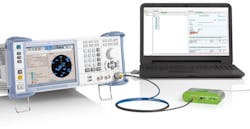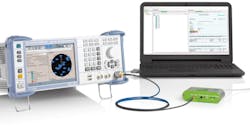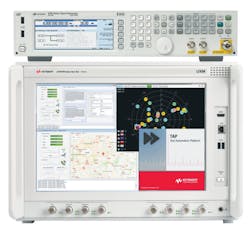Beginning April 1, the eCall system will be required in all new passenger cars and light trucks sold in the European Union. Test and certification company DEKRA explains that eCall recognizes airbag deployment and impact sensor information. Upon activation, the system communicates location data and sensor information to emergency services and establishes a voice call between the vehicle passengers and the emergency services. DEKRA cites estimates that eCall could accelerate emergency-service response times by 40% in urban areas and 50% in rural areas.
Of course, the eCall systems must be proven to work. To that end, DEKRA announced last November that it can now provide testing services and type approvals in accordance with directive EU 2017/79, which defines the technical prerequisites and procedures for eCall built-in systems, units, and components. DEKRA said it has been actively involved in the development and implementation of the system from the start as part of its connected-driving initiative for connected-car testing and certification.
Test software
Test-equipment makers are stepping up as well to support eCall technology with new software for their wireless communications test platforms. For example, Rohde & Schwarz announced in January that its eCall solution is certified by independent test body CETECOM, which performs eCall certification and has examined the implementation of the eCall test public safety answering point (PSAP) in the Rohde & Schwarz solution for the pan-European emergency call system and has certified it as compliant with the CEN EN 16454:2015 standard. Rohde & Schwarz said its R&S CMW-KA094 test solution is the first independently certified test PSAP system based on a wireless-communications test platform.
The R&S CMW-KA094 application software specifically developed for eCall is based on the R&S CMW500 platform in combination with the R&S SMBV100A GNSS simulator. The software simulates a PSAP and controls the R&S CMW500, which emulates a mobile network in the lab. It also controls the GNSS simulator, which provides the position data that would indicate an accident’s location. The R&S SMBV100A also supports the GNSS receiver performance tests in accordance with EU 2017/79 Annex VI. The eCall test solution can be fully automated with the R&S CMWrun sequencer software for further conformance tests, enabling users to directly utilize ready-made test sequences for eCall and ERA-GLONASS modules compliant with ETSI TS 103 412, CEN EN 16454 or GOST 33467.
Rohde & Schwarz said test houses and vehicle manufacturers use this solution for type approvals and for other tests requiring the emulation of mobile networks, such as location-independent testing of a car telephone.
Rohde & Schwarz said it is also developing test features for the next-generation eCall over LTE system and for testing new vehicle telematics units. Along with eCall, Rohde & Schwarz supports the automobile industry with test solutions for V2X communications.
Rohde & Schwarz also announced a new option for the R&S SMBV100A vector signal generator that, together with test-automation software, delivers standard-compliant, fully automated performance tests for the GNSS receiver integrated in an eCall module, which typically evaluates signals from GPS, Galileo, and satellite-based augmentation systems (SBAS) to determine vehicle position (Figure 1).
Courtesy of Rohde & Schwarz
To make sure the accuracy of the reported position, as well as other performance parameters are within limits, the built-in GNSS receiver must be tested against the criteria defined in the EU2017/79 Annex VI and UNECE 2016/07 specifications. The R&S SMBV100A in combination with the new R&S SMBV-K361 option and the R&S CMWrun sequencer software can perform fully automated GNSS performance tests on eCall modules in line with the EU2017/79 Annex VI and UNECE 2016/07 specifications. All test cases specified in these documents can be configured, scheduled, and conducted automatically, enabling users to quickly and easily verify the positioning capabilities of their eCall modules and to accelerate the certification process.
Emulator tests IVS modules
In addition, Keysight Technologies announced in February that Keysight’s PSAP test emulator software, part of Keysight’s E6950A eCall Conformance Test Solution, has been certified by NavCert GmbH. The certification was awarded Dec. 18, 2017, and customers can therefore be assured that when they have successfully tested in-vehicle-system (IVS) modules using the PSAP emulator, the modules will be compliant to these standards, Keysight reported.
The complete solution includes a UXM wireless test set plus an EXG vector signal generator (Figure 2) and an optional audio analyzer for parallel testing of speech quality. It provides GNSS coordinates required by the IVS to compile the minimum set of data (MSD). This setup makes it possible to verify that the IVS or modem can trigger an emergency call, send the correct raw MSD data, and establish a voice connection with the PSAP, testing both Pan European and ERA-GLONASS platforms, independent of any real-world mobile network.
Courtesy of Keysight Technologies
The PSAP emulator can run on the UXM and therefore does not require an external PC. It also enables a “Live Network Mode,” which allows functional test of an IVS module using a commercial mobile phone in real-world scenarios, such as testing emergency calls in poor reception areas or checking the survivability of an IVS module during a crash test.
NavCert, which provides type approval for eCall, has certified the Keysight PSAP Emulator as compliant with the EN 16454 and EN 15722 standards, Keysight said.
For more information:
About the Author

Rick Nelson
Contributing Editor
Rick is currently Contributing Technical Editor. He was Executive Editor for EE in 2011-2018. Previously he served on several publications, including EDN and Vision Systems Design, and has received awards for signed editorials from the American Society of Business Publication Editors. He began as a design engineer at General Electric and Litton Industries and earned a BSEE degree from Penn State.


